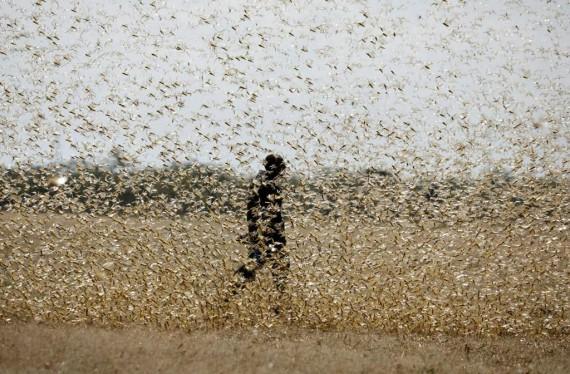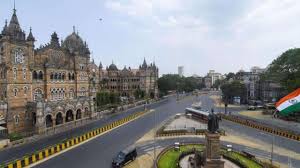Mumbai: The skies over six blocks in three districts of Maharashtra darkened on Tuesday as a swarm of locusts entered the state almost 17 years after the last locust invasion.
A swarm of desert locusts, which is a type of a species of short-horned grasshoppers, flew across Vidarbha’s Amravati, Wardha and Nagpur, and while major food crops are not under threat, as the sowing season is still a fortnight away, fruit orchards and vegetable farms are likely to be affected by the crop munching insects. They were spotted descending on orange orchards of Katol in Nagpur, as well as the neem trees in Morshi and Warud in Amravati.
According to the state agriculture department the swarm is reported to be at least 10km long and 2km wide — the insects are unique in the way that they change their behaviour from solitary to gregarious insects that forage for food together — and the swarm has covered a distance of about 120 km in the past three days.
“The invasion began from Katol (in Nagpur) on Monday morning. While major crop damage is not expected since we are close to monsoon and sowing in these areas begins by June 7, orange orchards are threatened by this invasion. A 25% loss is being estimated as of now for those owing these orchards,” said Ravindra Bhosale, divisional joint director agriculture, Nagpur division.
As the swarm moves further south into the rural areas of Nagpur like Kamleshwar, hectares of cabbage, ladyfinger, cauliflower, and kidney beans crops are under threat.
“An escaping population of desert locusts made their way from Madhya Pradesh into Amravati district on May 24 due to the current wind direction and the presence of forest patches where they can grow and breed as well as citrus trees. Over 48 hours, they have covered to two more districts showing an unusual swarming behaviour,” said Dr KL Gurjar, deputy director and national coordinator on mitigating locust attacks, Locust Warning Organisation, adding that the last time Maharashtra witnessed such an invasion was in 1993, in Dhule.
Subhash Nagade, divisional joint director agriculture, Amravati division said the locust swarm has only exacerbated villagers’ woes who are already dealing with Covid-19 cases and the extremely hot weather.
However, the government has been tackling the issue. While the locusts themselves pose no harm to humans, they can only be killed using chemicals. District officials, with the help of the fire department carried out hours-long drives of spraying pesticides across affected areas in all three districts in the intervening night between Monday and Tuesday.
“We learnt that the swarms were asleep on the citrus trees. The villagers were able to pin point the exact locations, and an overnight extermination drive saw thousands of dead insects across a 17-km stretch at Katol. However, on Tuesday morning, those that survived began swarming to other talukas,” said Bhosale.
“We expect the invasion to be controlled within a few days in Maharashtra. However, another escaping population from MP cannot be ruled out,” Gurjar said, adding that the wind direction was the reason behind such a possibility.
Gurjar also said that efforts were on to control locust in Jaipur, Dausa and Karauli regions in Rajasthan and added that all state governments have been given instructions on how to control the fast migrating pest.
The country is witnessing a severe locust outbreak active across Rajasthan, Gujarat, Uttar Pradesh, Madhya Pradesh, and now Maharashtra. These rapidly reproducing crop munching pests can fly up to 150km in a day. Central and state bodies have stepped up efforts to control the menace as it poses crop vulnerability and threat to food safety if the outbreak is not contained.
Experts said the outbreak started due to heavy rain over east Africa and Arabian Peninsula due to warm waters in the western Indian Ocean in late 2019 with the swarm originating in the Horn of Africa, and entered India after breeding in Baluchistan, Iran and Pakistan.
“These warm waters were caused by the phenomenon called the Indian Ocean Dipole—with warmer than usual waters to its west, and cooler waters to its east. Rising temperatures due to global warming amplified the dipole and made the western Indian Ocean particularly warm,” said Dr Roxy Mathew Koll, Senior Scientist, Indian Institute of Tropical Meteorology, adding that the locusts migrating to India may have found greener pastures due to above normal pre-monsoon rains during March–May for north and central India, including the Vidarbha region. “Heavy rain triggers the growth of vegetation in arid areas where desert locusts can then grow and breed.”




























 WhatsApp us
WhatsApp us
Pingback: keto reset diet recipes
Pingback: nyc gay dating
Pingback: lumigan drops
Pingback: clomid australia buy
Pingback: aralen otc
Pingback: lumigan gotas
Pingback: zanaflex pill
Pingback: tizanidine
Pingback: 3autograph
Pingback: ดูซีรี่ย์ออนไลน์
Pingback: ราคาบอลวันนี้
Pingback: lsm99live.net
Pingback: รับทำ SEO สายขาว